A Mixed Uncertainty Power Flow Algorithm-Based Centralized Photovoltaic (PV) Cluster
Abstract
:1. Introduction
2. Centralized PV Clusters
2.1. Description of Centralized PV Clusters
2.2. Modeling of PV Power Generation Units
2.3. Impedance Modeling and Voltage Out-of-Limit Analysis of Centralized PV Clusters
3. Interval Analysis
3.1. Interval Arithmetic
3.2. Affine Arithmetic
3.3. Krawczy-Moore Interval Operator
4. Interval Analysis
4.1. Mixed Uncertain Power Flow Model for Centralized PV Clusters
4.2. The Processing of Jacobi Matrix Elements
4.3. Calculation Steps of Mixed Uncertain Power Flow
5. Simulation Analysis
5.1. Simulation Parameter Setting
5.2. Comparison and Analysis of Simulation Results for Centralized PV Clusters
5.3. Voltage Operating Condition Under Different Volatility
5.4. Voltage Operating Condition Under Different Partial Shading Conditions
6. Conclusions
Author Contributions
Funding
Conflicts of Interest
References
- Liu, D.; Liu, M.; Xu, E. Comprehensive effectiveness assessment of renewable energy generation policy: A partial equilibrium analysis in China. Energy Policy 2018, 115, 330–341. [Google Scholar] [CrossRef]
- China Photovoltaic Industry Association. 2018. Available online: http://www.chinapv.org.cn (accessed on 31 March 2019).
- Niu, M.; Wan, C.; Xu, Z. A review on applications of heuristic optimization algorithms for optimal power flow in modern power systems. J. Mod. Power Syst. Clean Energy 2014, 2, 289–297. [Google Scholar] [CrossRef] [Green Version]
- Wang, Q.; Chang, P.; Bai, R. Mitigation Strategy for Duck Curve in High Photovoltaic Penetration Power System Using Concentrating Solar Power Station. Energies 2019, 12, 3521. [Google Scholar] [CrossRef]
- Xu, C.; Gu, W.; Gao, F. Improved affine arithmetic based optimisation model for interval power flow analysis. IET Gener. Transm. Distrib. 2016, 10, 3910–3918. [Google Scholar] [CrossRef]
- Albatsh, F.M.; Ahmad, S.; Mekhilef, S. Fuzzy-Logic-Based UPFC and Laboratory Prototype Validation for Dynamic Power Flow Control in Transmission Lines. IEEE Trans. Ind. Electron. 2017, 64, 9538–9548. [Google Scholar] [CrossRef]
- Zhao, Q.; Shao, S.; Lu, L. A New PV Array Fault Diagnosis Method Using Fuzzy C-Mean Clustering and Fuzzy. Energies 2018, 11, 238. [Google Scholar] [CrossRef]
- Williams, T.; Crawford, C. Probabilistic Load Flow Modeling Comparing Maximum Entropy and Gram-Charlier Probability Density Function Reconstructions. IEEE Trans. Power Syst. 2013, 28, 272–280. [Google Scholar] [CrossRef]
- Fan, M.; Vittal, V.; Heydt, G.T. Probabilistic Power Flow Studies for Transmission Systems with Photovoltaic Generation Using Cumulants. IEEE Trans. Power Syst. 2012, 27, 2251–2261. [Google Scholar] [CrossRef]
- Caramia, P.; Carpinelli, G.; Varilone, P. Point estimate schemes for probabilistic three-phase load flow. Electr. Power Syst. Res. 2010, 80, 168–175. [Google Scholar] [CrossRef]
- Ni, F.; Nguyen, P.H.; Cobben, J.F.G. Basis-Adaptive Sparse Polynomial Chaos Expansion for Probabilistic Power Flow. IEEE Trans. Power Syst. 2017, 32, 694–704. [Google Scholar] [CrossRef]
- Wang, Z.; Alvarado, F.L. Interval arithmetic in power flow analysis. IEEE Trans. Power Syst. 1992, 7, 1341–1349. [Google Scholar] [CrossRef]
- Das, B. Radial distribution system power flow using interval arithmetic. Int. J. Electr. Power Energy Syst. 2002, 24, 827–836. [Google Scholar] [CrossRef]
- Pereira, L.E.S.; Da, C.V.M.; Rosa, A.L.S. Interval arithmetic in current injection power flow analysis. Int J. Electr. Power Energy Syst. 2012, 43, 1106–1113. [Google Scholar] [CrossRef]
- Ding, T.; Bo, R.; Li, F. Interval Power Flow Analysis Using Linear Relaxation and Optimality-Based Bounds Tightening (OBBT) Methods. IEEE Trans. Power Syst. 2015, 30, 177–188. [Google Scholar] [CrossRef]
- Liao, X.; Liu, K.; Le, J. Review on Interval Power Flow Calculation Methods in Power System. Proc. CSEE 2019, 39, 447–459. (In Chinese) [Google Scholar]
- Vaccaro, A.; Canizares, C.A.; Villacci, D. An Affine Arithmetic-Based Methodology for Reliable Power Flow Analysis in the Presence of Data Uncertainty. IEEE Trans. Power Syst. 2010, 25, 624–632. [Google Scholar] [CrossRef]
- Liao, X.; Liu, K.; Niu, H. An interval Taylor-based method for transient stability assessment of power systems with uncertainties. Int. J. Electr. Power Energy Syst. 2018, 98, 108–117. [Google Scholar] [CrossRef]
- Vaccaro, A.; Canizares, C.A.; Bhattacharya, K.A. Range Arithmetic-Based Optimization Model for Power Flow Analysis under Interval Uncertainty. IEEE Trans. Power Syst. 2013, 28, 1179–1186. [Google Scholar] [CrossRef]
- Zhang, C.; Chen, H.; Shi, K. An Interval Power Flow Analysis through Optimizing-Scenarios Method. IEEE Trans. Smart Grid 2017, 9, 5217–5226. [Google Scholar] [CrossRef]
- Wang, S.; Shao, Z. Interval power-flow algorithm based on complex affine Ybus-Gaussian iteration considering uncertainty of DG operation. Electr. Power Autom. Equip. 2017, 37, 38–44. (In Chinese) [Google Scholar]
- Ding, T.; Cui, H.; Gu, W. An uncertainty power flow algorithm based on interval and affine arithmetic. Autom. Electr. Power Syst. 2012, 36, 51–55. (In Chinese) [Google Scholar]
- Shah, R.; Mithulananthan, N.; Bansal, R.C. Power system voltage stability as affected by large-scale PV penetration. In Proceedings of the IEEE International Conference on Electrical Engineering and Informatics, Bandung, Indonesia, 17–19 July 2011. [Google Scholar]
- Pandey, A.; Jereminov, M.; Wagner, M.R. Robust Power Flow and Three-Phase Power Flow Analyses. IEEE Trans. Power Syst. 2019, 34, 616–626. [Google Scholar] [CrossRef]
- Wang, Y.; Wu, C.; Liao, H. Study on impacts of large-scale photovoltaic power station on power grid voltage profile. In Proceedings of the IEEE International Conference on Electric Utility Deregulation & Restructuring & Power Technologies, Nanjing, China, 6–9 April 2008. [Google Scholar]
- Daniela, F.; Paola, S.; Franco, F. Electroluminescence Test to Investigate the Humidity Effect on Solar Cells Operation. Energies 2018, 11, 2659. [Google Scholar] [Green Version]
- Alonso, G.G.; Michael, B.; Fernando, J.V. Shading Ratio Impact on Photovoltaic Modules and Correlation with Shading Patterns. Energies 2018, 11, 852. [Google Scholar] [Green Version]
- Nur, H.Z. Lightning Surge Analysis on a Large Scale Grid-Connected Solar Photovoltaic System. Energies 2017, 10, 2149. [Google Scholar] [Green Version]
- Alefeld, G.; Mayer, G. Interval analysis: Theory and applications. J. Comput. Appl. Math. 2000, 121, 421–464. [Google Scholar] [CrossRef]
- Figueiredo, L.D.; Stolfi, J. Affine arithmetic: Concepts and applications. Numer. Algorithms 2004, 37, 47–158. [Google Scholar] [CrossRef]
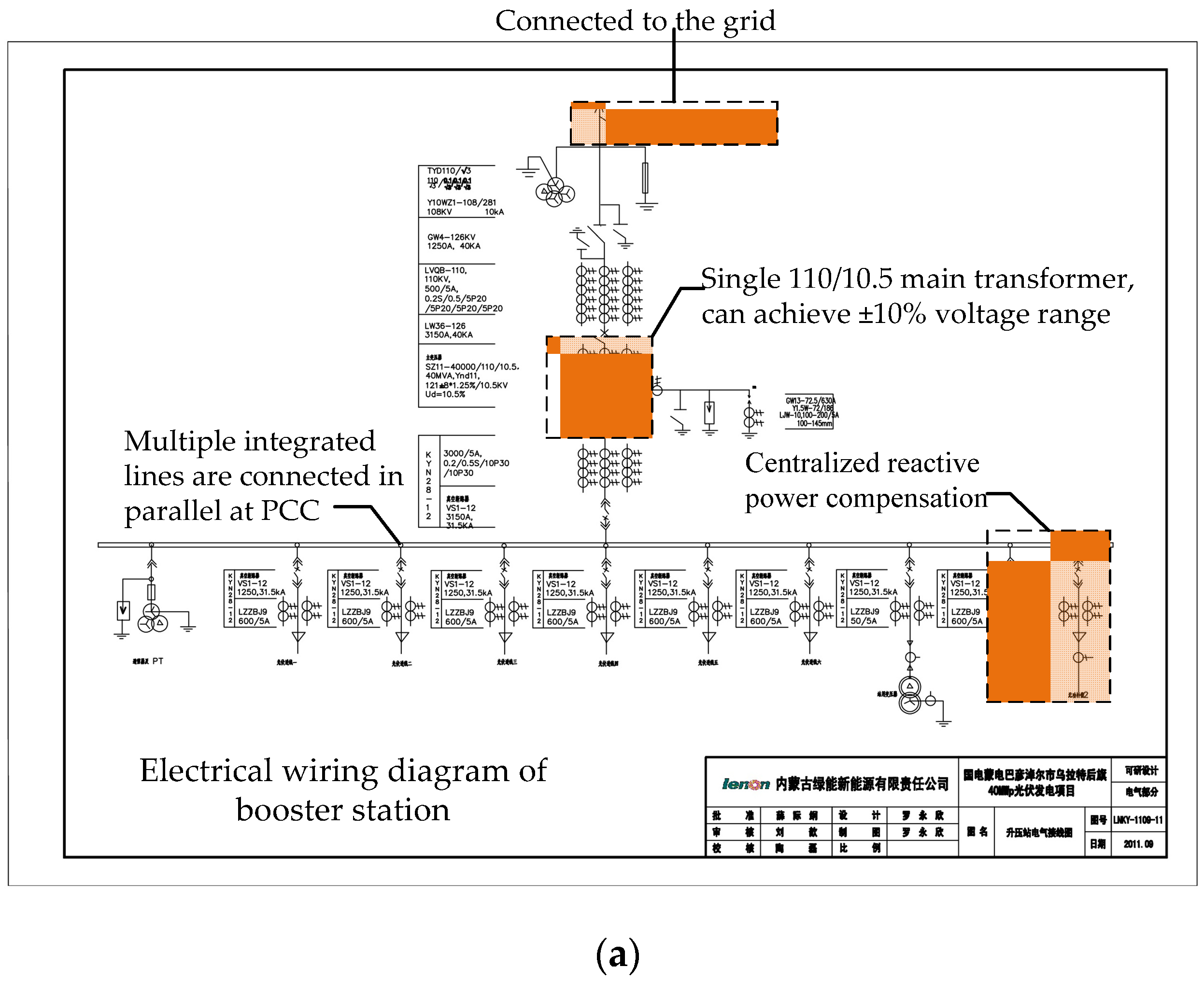
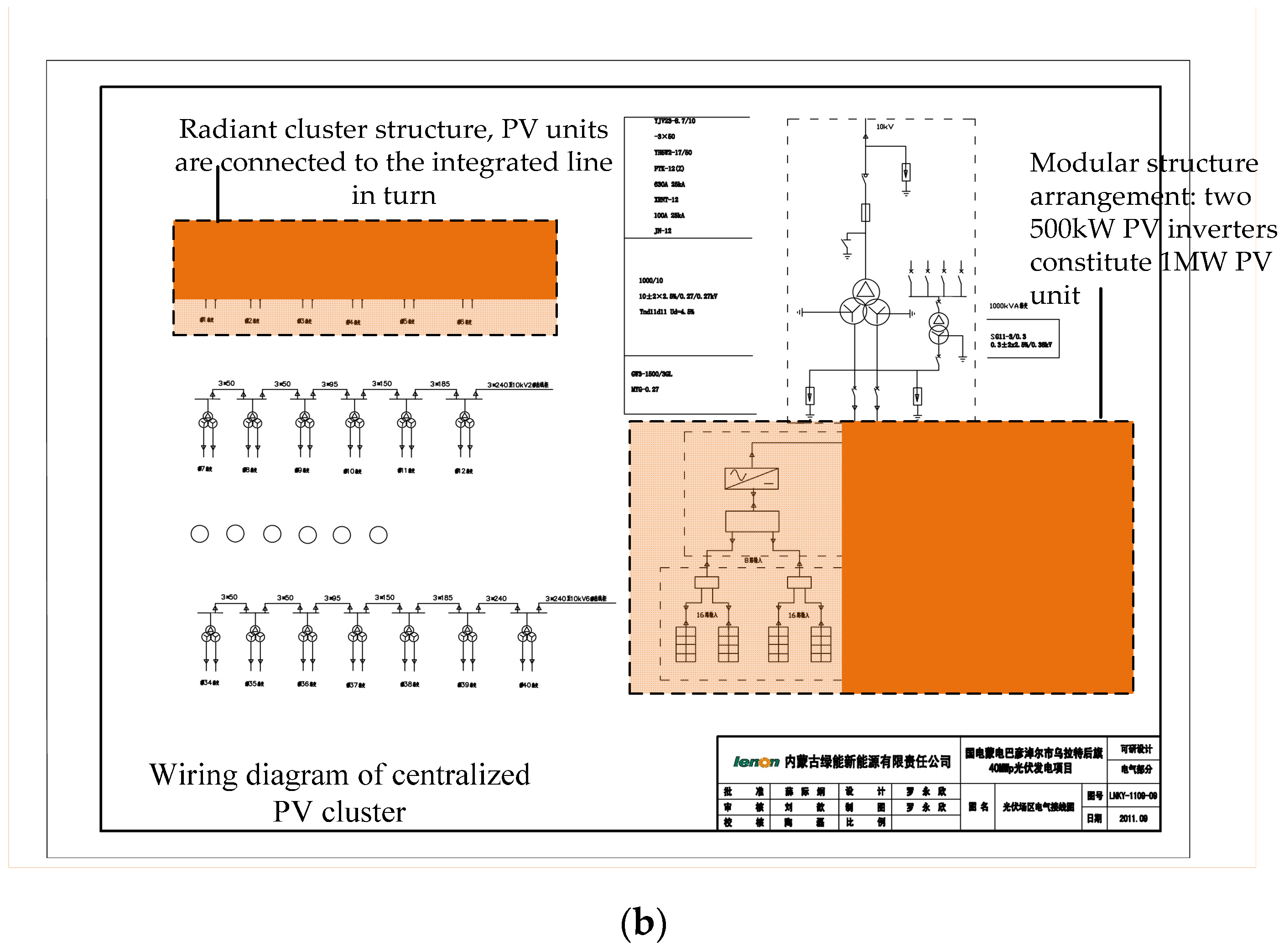
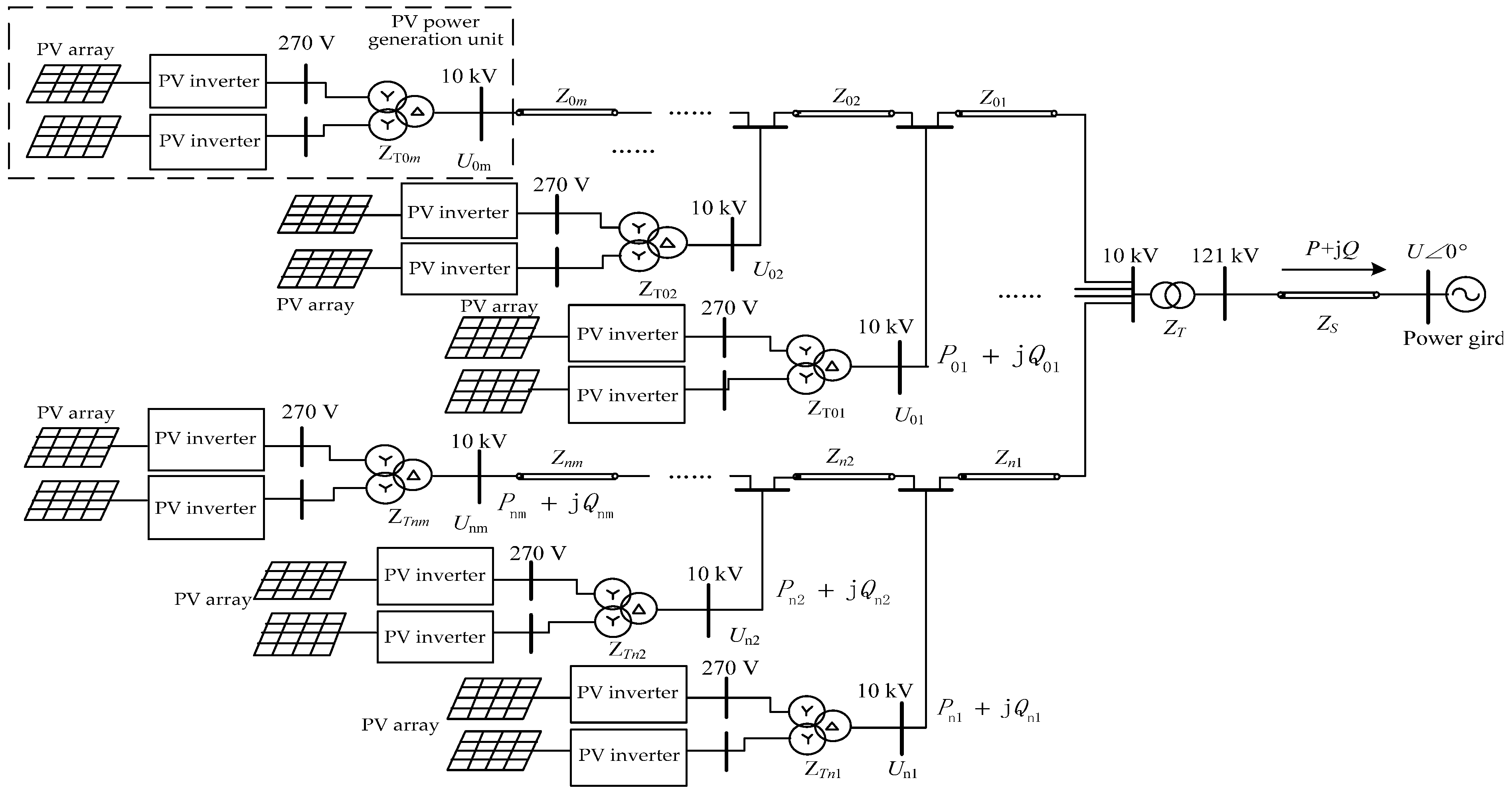
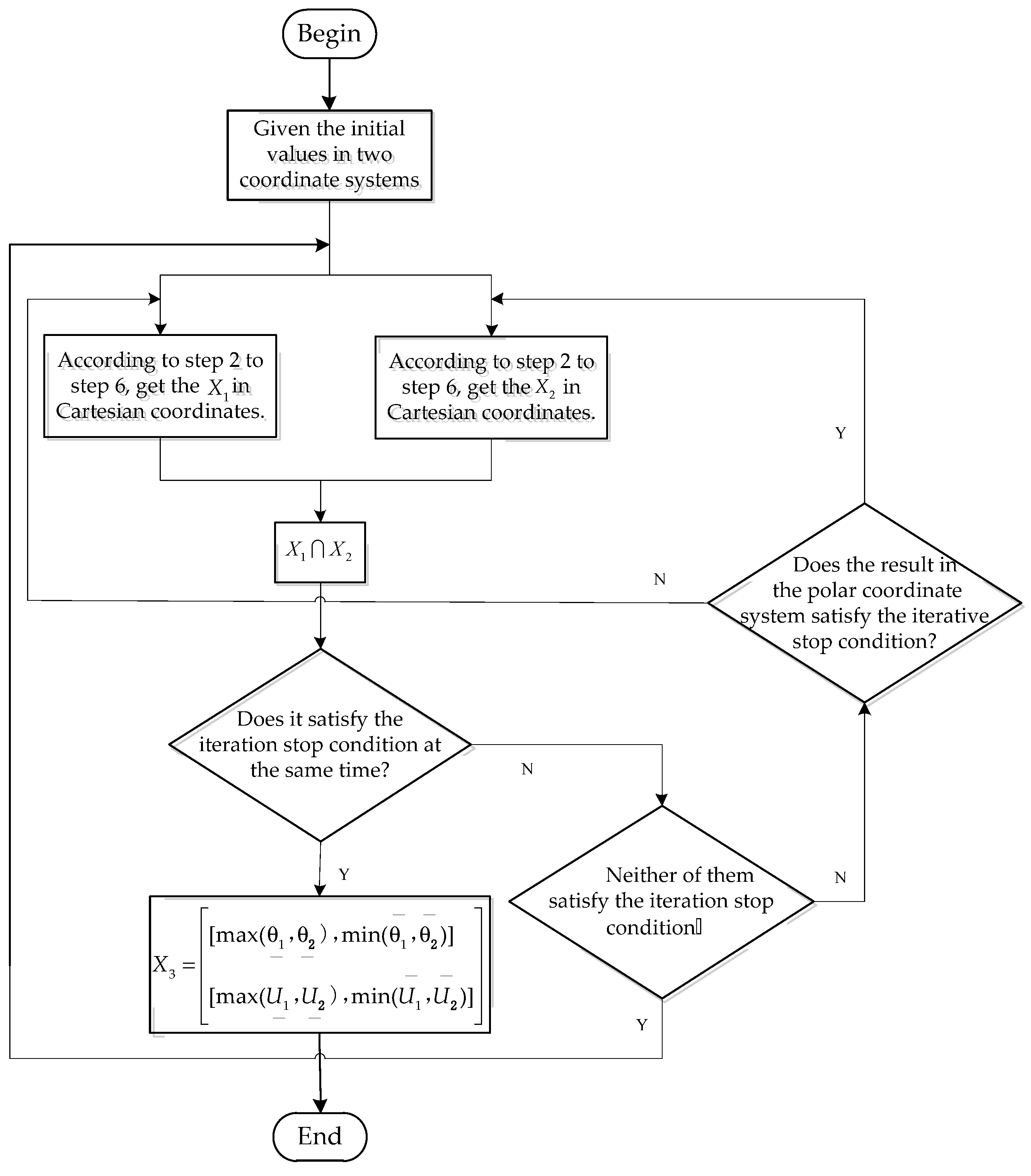
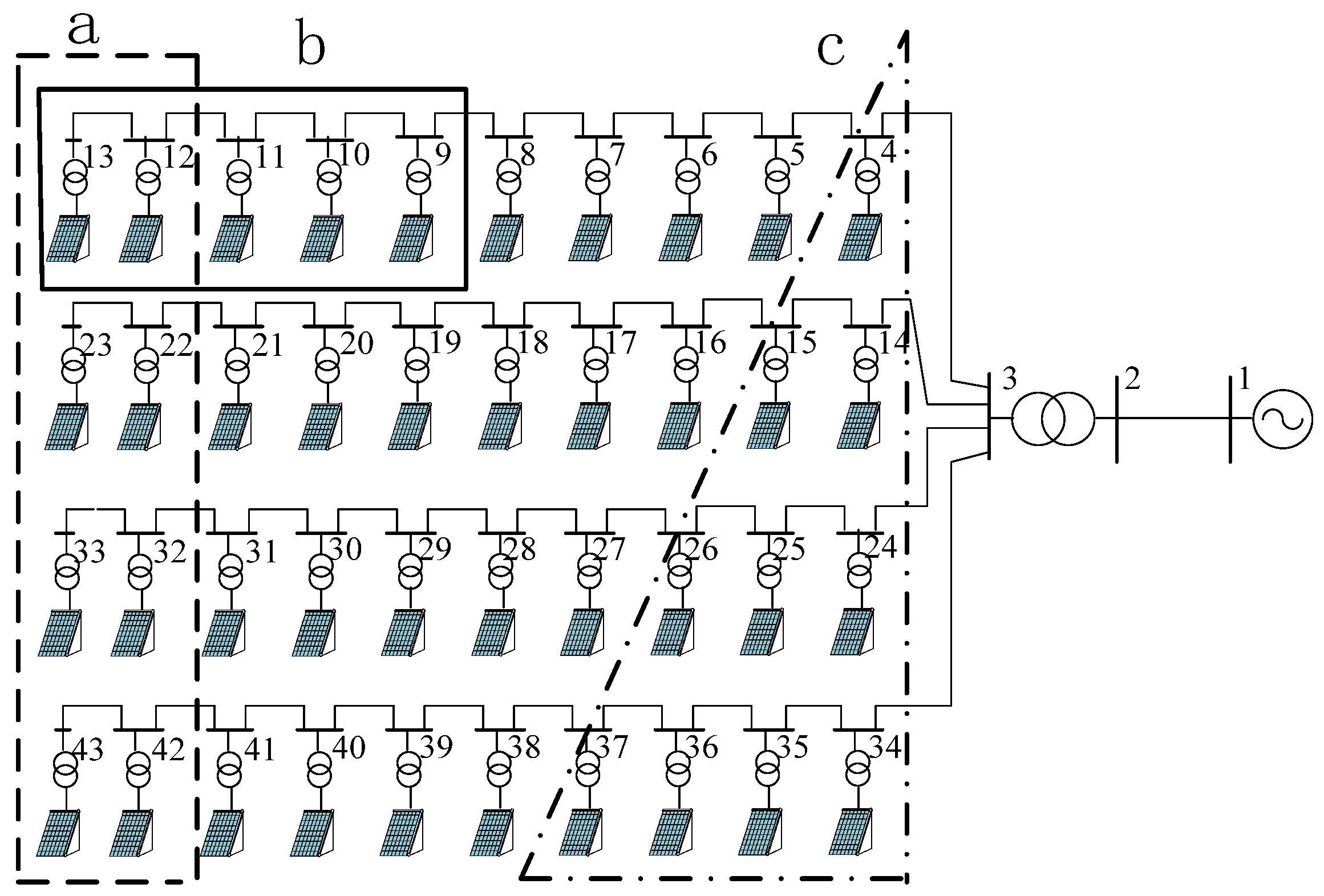
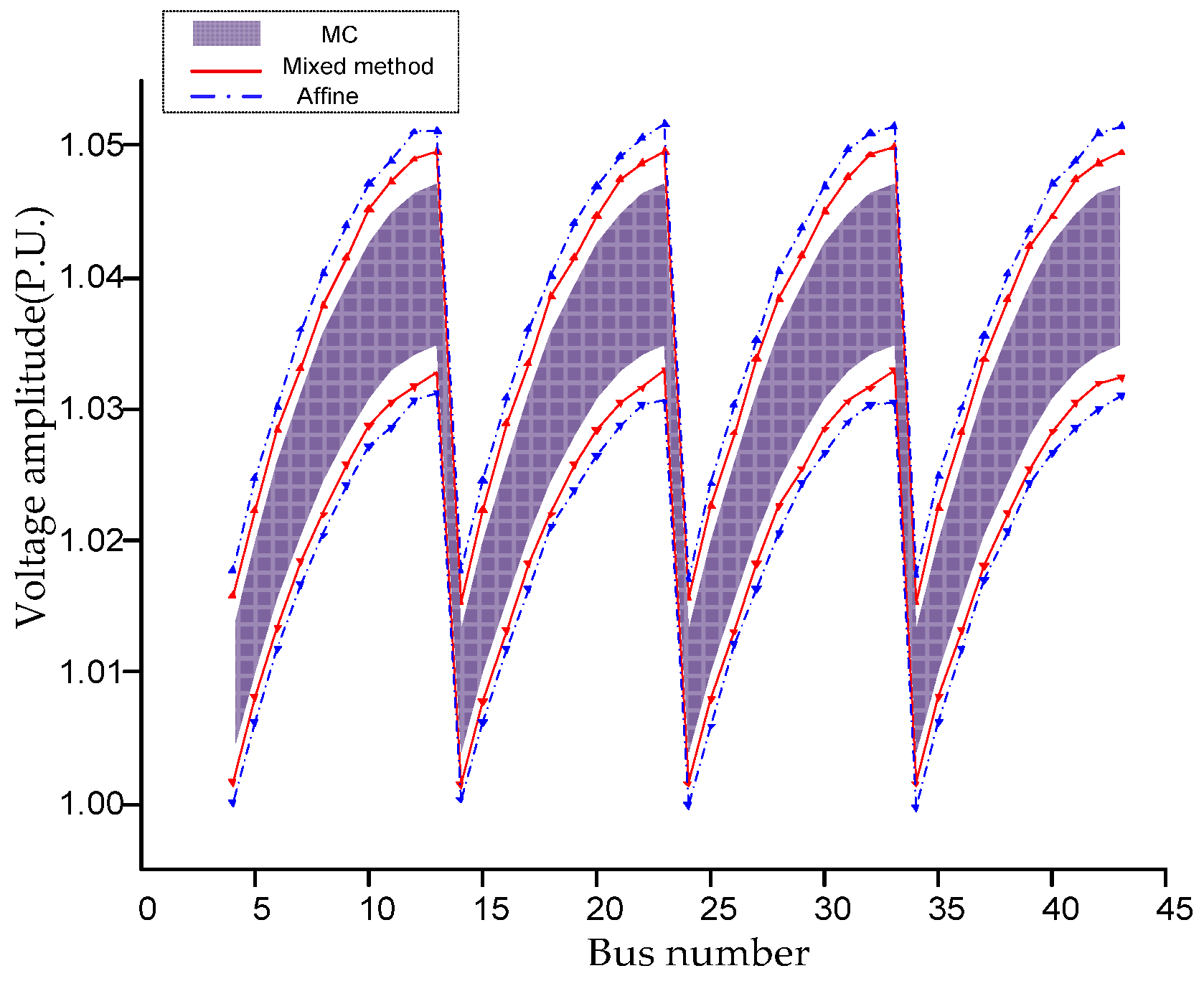

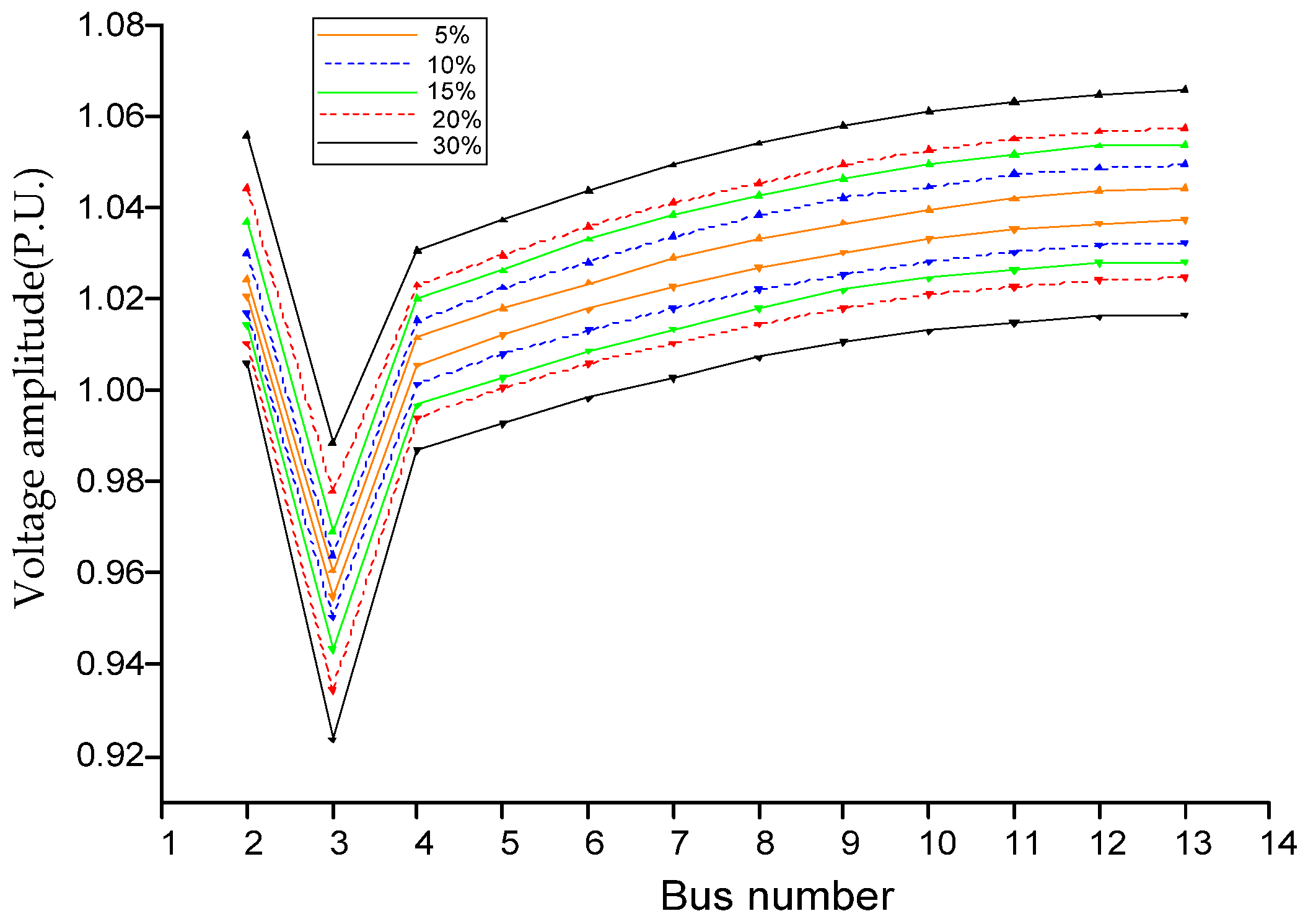
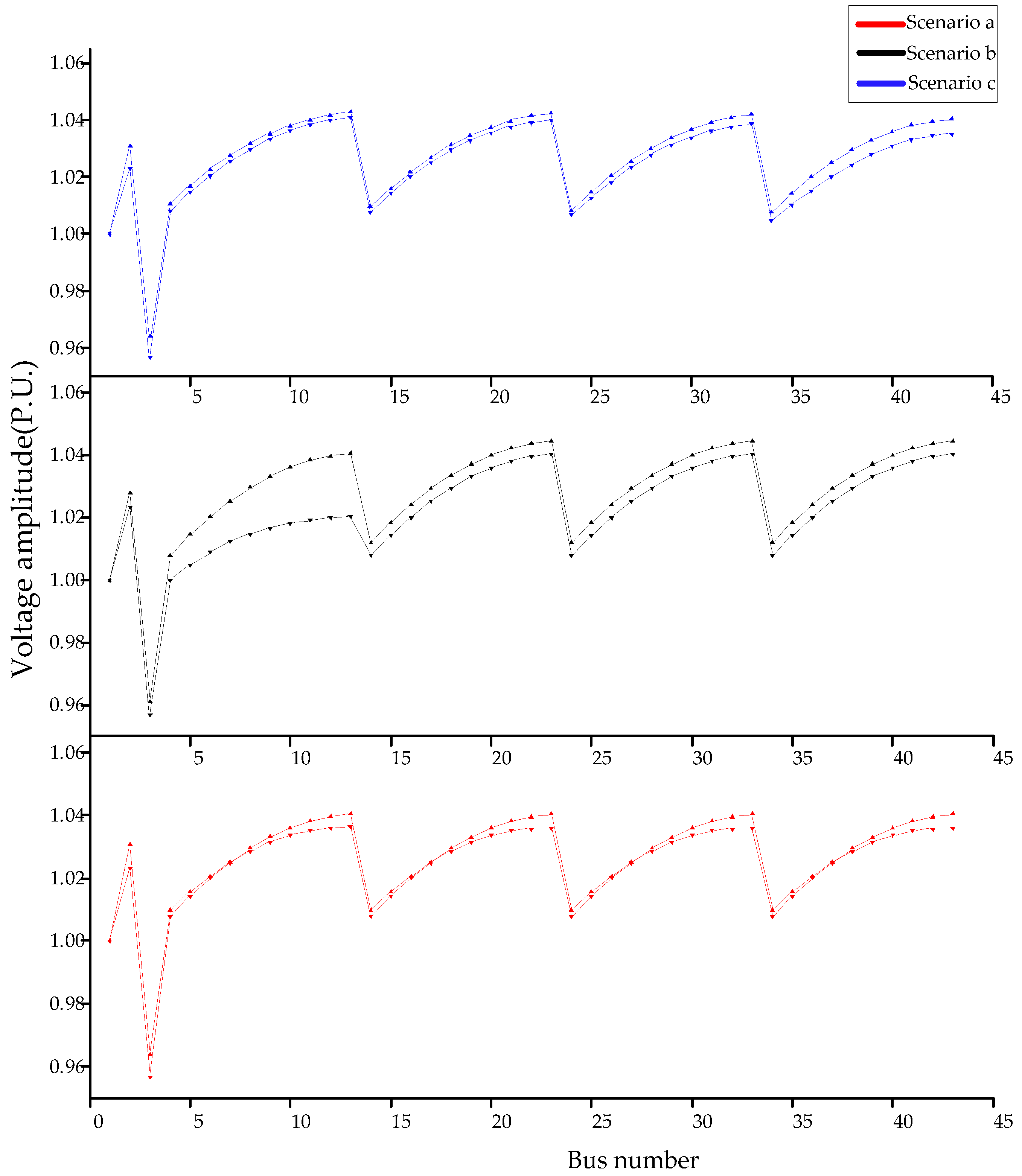
| Type | |||
|---|---|---|---|
| YJV23-8.7/10 | 0.128 | 0.0113 | - |
| LGJ185 | 0.17 | 0.402 | 2.78 × 10−6 |
| Type | |||
|---|---|---|---|
| Split transformer | 1.155 | 10.3 | 4.5% |
| Main transformer | 29.44 | 148.8 | 10.5% |
| Node Number | MC | Mixed Method | Affine |
|---|---|---|---|
| 2 | [1.0195, 1.0281] | [1.0171, 1.0302] | [1.0156, 1.0326] |
| 3 | [0.9530, 0.9615] | [0.9506, 0.9638] | [0.9494, 0.9659] |
| Node Number | MC | Mixed Method | Affine |
|---|---|---|---|
| 2 | [18.25, 20.11] | [17.71, 20.65] | [17.50, 20.89] |
| 3 | [20.52, 22.50] | [19.95, 23.02] | [19.74, 23.24] |
| Type | Mixed Method | Affine |
|---|---|---|
| Voltage error rate | 0.20–0.28% | 0.38–0.46% |
| Phase angle error rate | 2.1–3.0% | 3.1–4.2% |
© 2019 by the authors. Licensee MDPI, Basel, Switzerland. This article is an open access article distributed under the terms and conditions of the Creative Commons Attribution (CC BY) license (http://creativecommons.org/licenses/by/4.0/).
Share and Cite
Wu, H.; Zhou, L.; Wan, Y.; Liu, Q.; Zhou, S. A Mixed Uncertainty Power Flow Algorithm-Based Centralized Photovoltaic (PV) Cluster. Energies 2019, 12, 4008. https://doi.org/10.3390/en12204008
Wu H, Zhou L, Wan Y, Liu Q, Zhou S. A Mixed Uncertainty Power Flow Algorithm-Based Centralized Photovoltaic (PV) Cluster. Energies. 2019; 12(20):4008. https://doi.org/10.3390/en12204008
Chicago/Turabian StyleWu, Hao, Lin Zhou, Yihao Wan, Qiang Liu, and Siyu Zhou. 2019. "A Mixed Uncertainty Power Flow Algorithm-Based Centralized Photovoltaic (PV) Cluster" Energies 12, no. 20: 4008. https://doi.org/10.3390/en12204008
APA StyleWu, H., Zhou, L., Wan, Y., Liu, Q., & Zhou, S. (2019). A Mixed Uncertainty Power Flow Algorithm-Based Centralized Photovoltaic (PV) Cluster. Energies, 12(20), 4008. https://doi.org/10.3390/en12204008




